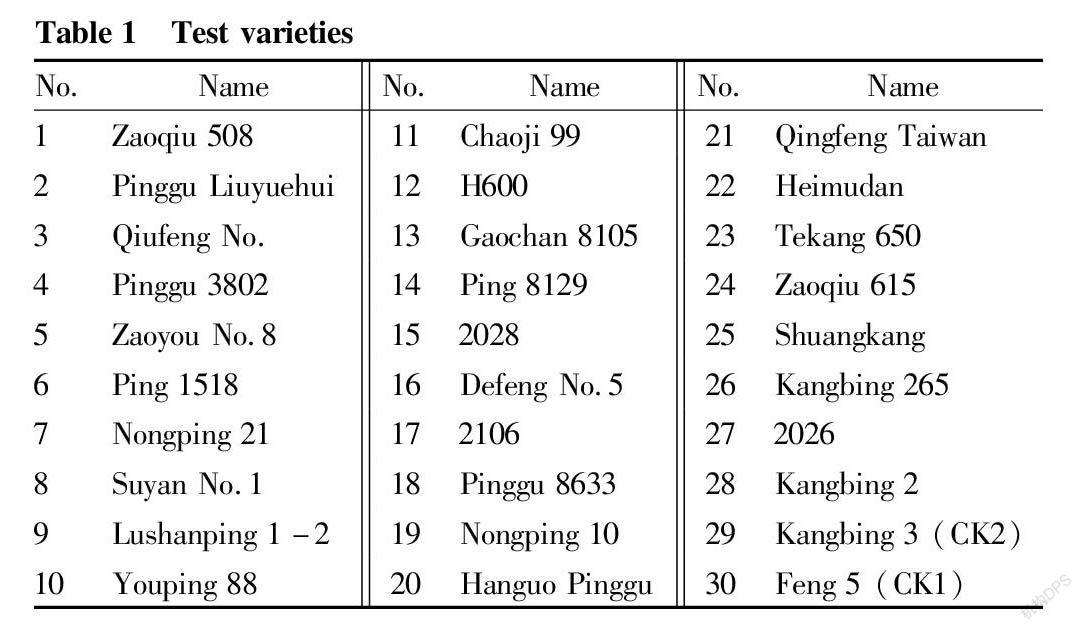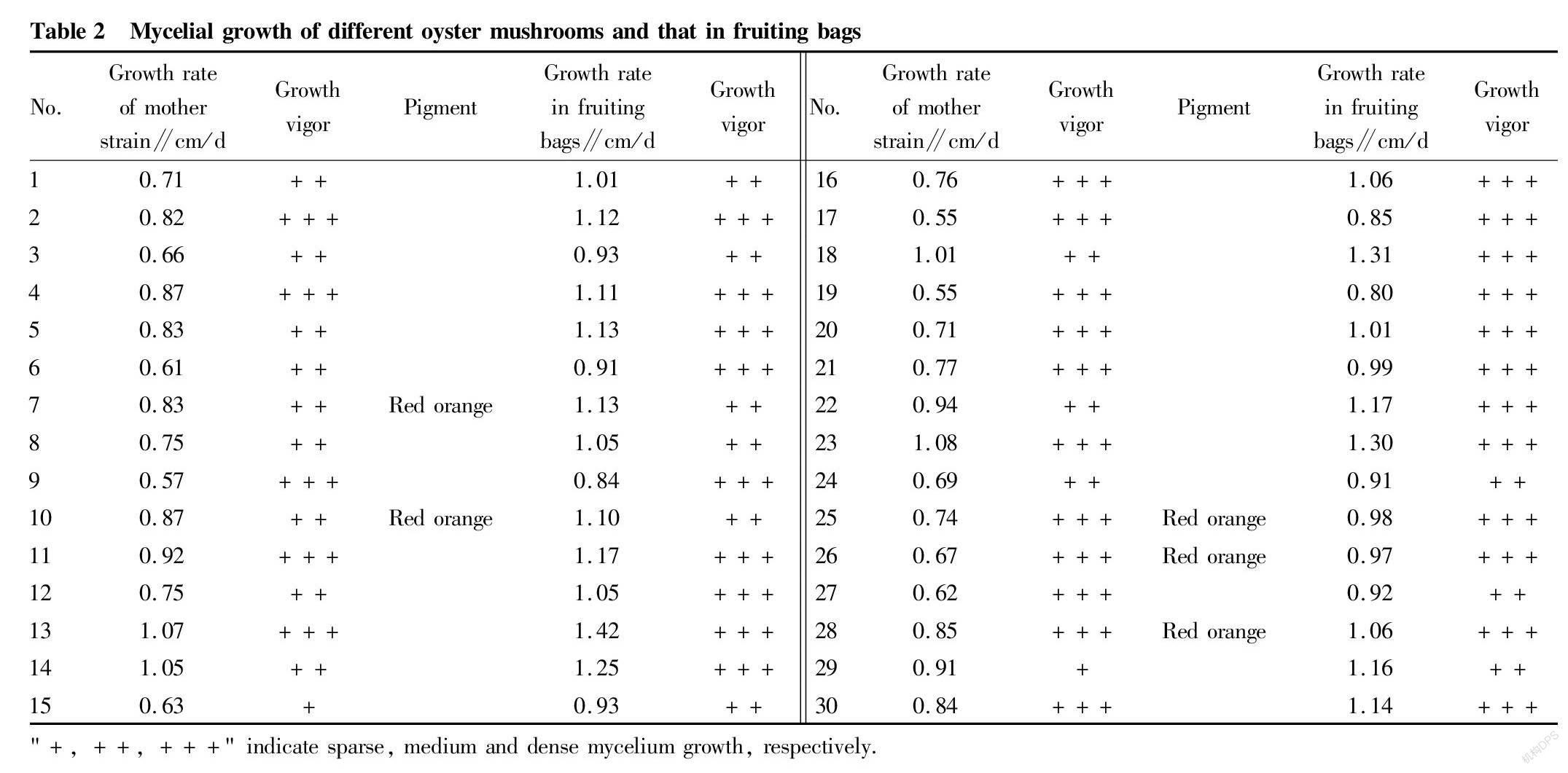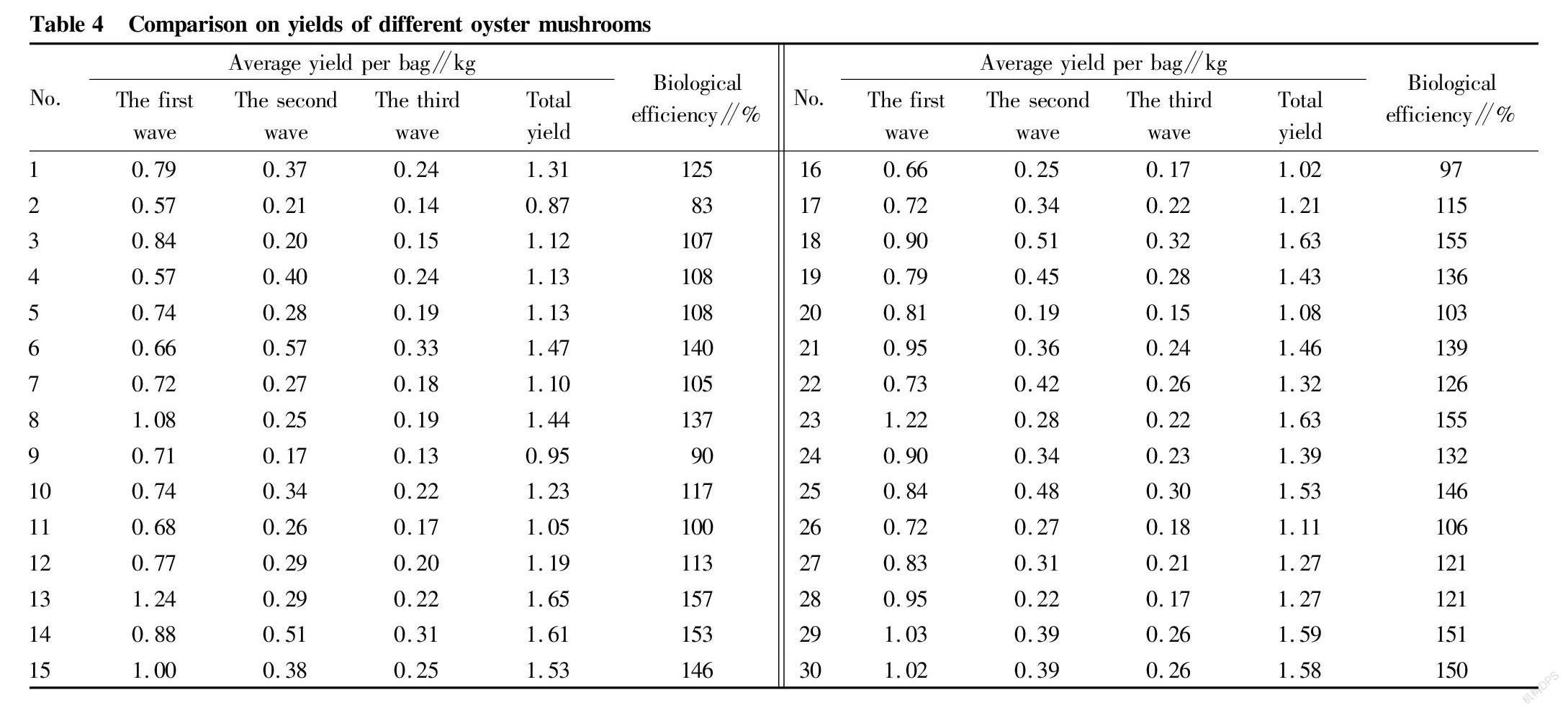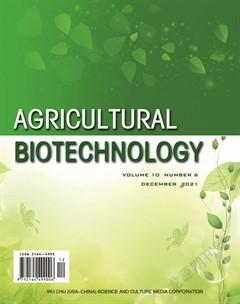Comparison Test of Black Grey Oyster Mushrooms in Shandong Province in Winter and Spring
Jiale ZHOU Jiandong HAN Chunyan HUANG Qiang YAO Hongyan XIE Peng YANG Jin LI




Abstract [Objectives] This study was conducted to screen high-yield and high-quality strains suitable for promotion and cultivation in Shandong Province in winter and spring, and provide production enterprises with better production strains.
[Methods]The clinker bag cultivation method was used to compare the cultivated products of 30 Pleurotus spp. strains, and the data on mycelial growth rate, growth morphology, biological characteristics of fruit bodies and yield were collected for comparison.
[Results] Compared with other strains, such four strains as Pinggu 8633, Gaochan 8105, Tekang 650 and Ping 8129 had significantly higher adaptability, higher yield and better marketability.
[Conclusions]Pinggu 8633, Gaochan 8105, Tekang 650 and Ping 8129 can be used as the main varieties for winter and spring oyster mushrooms production in Shandong Province.
Key words Oyster mushrooms; Comparison test; Cultivated strains
Received: October 5, 2021 Accepted: November 6, 2021
Supported by Agricultural Science and Technology Innovation Project of Shandong Academy of Agricultural Sciences (CXGC2021A33); Key R&D Project of Shandong Province (2018GNC110012); The Modern Agricultural Industry Technology System (CARS-20).
Jiale ZHOU (1997-), female, P. R. China, master, devoted to research about microbiology.
*Corresponding author. E-mail: lj_saas@sohu.com.
Oyster mushrooms are one of the most widely cultivated edible mushrooms in China. Shandong Province is the main producing area of oyster mushrooms. The output of oyster mushrooms in 2019 was 1 157 800 t, accounting for 16.87% of the national output of oyster mushrooms. Shandong Province occupies an important position in the national edible fungus industry. Based on the screening of high-yielding and high-quality strains suitable for promotion and cultivation in Shandong Province in winter and spring, and for the purpose of providing production companies with better production strains, from November 2019 to May 2020, 30 dark gray Pleurotus spp. strains preserved by Shandong Academy of Agricultural Sciences were compared with cultivated products, and the results were now given as below.
Materials and Methods
Test strains
The tested varieties were all wide-temperature black gray oyster mushrooms, provided by Shandong Academy of Agricultural Sciences, as shown in Table 1.
Feng 5 and Kangbing 3 were used as control strains.
Medium formula
Mother strain: Standard PDA medium.
Original strain: Wheat grain medium.
The fruiting medium contained corncob 80%, wheat bran 15%, urea 0.5%, gypsum 1%, lime 3%, light calcium carbonate 0.5%, moisture content 60%, and was used in the autoclaved clinker bag planting mode. The fruiting bags used 17 cm×25 cm polypropylene. Each bag was filled with 1.75 kg, and 100 bags were prepared per variety.
Test methods
First, 30 Pleurotus spp. strains were inoculated into test tubes for activation, and then expanded and cultivated according to the original strains using fruiting bags. After inoculating to fruiting bags, they were cultivated in a constant temperature mushroom room at 23 ℃ and protected from light. After the hyphae grew up, they were moved into fruiting sheds. Each variety was divided into three experimental plots (A/B/C), each of which was stacked with 33 bags. Conventional management was adopted. The mushrooms were harvested and weighed for the first, second and third waves, and the yield and agronomic characteristics were recorded. Parameters such as the growth cycle of strains were calculated and analyzed and compared.
Determined items
① Growth rate and growth vigor of mycelia: Under the culture condition with the same temperature, the tested strains were inoculated to test tubes and fruiting bags. By marking the hypha growth circle, the daily growth rate of hyphae was calculated from the measured average distance between two marking lines, and the average value of strain data was taken for each index. Hypha morphology, growth and presence or absence of pigments were recorded.
① Observation of biological characteristics of fruit bodies: When the cap edge of the fruiting body is flat and the maturity reaches 70%-80%, it shall be harvested, weighed and recorded in time. And the cap color, gill color, cap diameter, cap thickness, stalk length, stalk diameter and other biological characteristics were observed, and the test data of different strains were the average values of each strain. The biological efficiency was calculated according to yield of fresh mushrooms/dry weight of raw materials.
On the basis of investigating the above indexes, the data of various indexes were analyzed and compared, and a comprehensive evaluation of various varieties was finally conducted.
Results and Analysis
Comparison of mycelial growth of different cultivated Pleurotus spp. strains
The growth of mycelia of different cultivated oyster mushrooms was compared, and the results are shown in Table 2.
Observation results showed that the 30 tested Pleurotus spp. strains could germinate quickly after being inoculated in test tubes and the fruiting medium. The hyphae began to utilize the materials at 72 h after inoculation to fruiting bags, and the hyphae were white and dense, and grew neatly, but the aerial hyphae of some varieties were dense and had red-orange pigment secretion. From the results in Table 2, it can be seen that the growth rate of each strain on fruiting bags was faster than that in PDA test tubes, but the trends of various varieties were basically the same; and in terms of growth rate, Pinggu 8633, Gaochan 8105, Tekang 650, and Ping 8129 had the fastest growth rate. The growth rate and growth vigor of mycelia are related to the viability and stress resistance of strains, and the strains with a fast growth rate and strong growth vigor have higher resistance to miscellaneous strains and diseases.
Comparison of fruit body traits of oyster mushrooms
The agronomic characteristics of the fruit bodies of oyster mushrooms determine their marketability of oyster mushrooms. Indexes closely related to the quality of oyster mushrooms include the shape of the mushroom, the color of mushroom bodies, the size of caps, the length of stipes, and toughness. We compared the agronomic characteristics of the fruit bodies of different oyster mushrooms, and the results are shown in Table 3.
From the results in Table 3, it can be seen that the tested oyster mushrooms could produce mushrooms within the temperature range of the test, and the fruit body color ranged from gray to black; and the average diameter of caps was between 6.5-13.2 cm, but the caps of H600 and Nongping No.10 were obviously larger than other strains, reaching more than 12 cm. Meanwhile, the caps of these large-cap Pleurotus spp. strains were also thicker, and there were fewer caps per stack. Judging from the toughness of the fruit bodies of the tested Pleurotus spp. strains, most Pleurotus spp. had good toughness and could meet the transportation requirements.
Comparison of the yields of different Pleurotus spp. strains
The yield results are shown in Table 4. Under the cultivation conditions used in this study, all the 30 strains tested could grow and fruit normally, and the conversion rate of some varieties could reach 150%, but the wave yield and total yield of different varieties were quite different. The biological conversion rate of most varieties exceeded 100%; and among them, only Pinggu 8633, Gaochan 8105, Tekang 650, and Ping 8129 had yields and biological efficiency higher than the control varieties, and their biological efficiency exceeded 150%, while the values of such three varieties as Defeng 5, Lushanping 1-2 and Pinggu Liuyuehui did not reach 100%.
Conclusions and Discussion
It could be seen from the test that, according to comprehensive analysis on mycelial growth, fruit body traits and yield levels of the tested strains, among the 30 tested strains, four strains of Pinggu 8633, Gaochan 8105, Tekang 650, and Ping 8129 were better than the control strains in terms of mycelial vigor and fruiting conditions, and can be considered as the main recommended varieties for winter and spring oyster mushrooms production in Shandong Province. Among the varieties with lower biological efficiency, Lushanping 1-2 is a variety collected and isolated from the field, and have a general mushroom type; and Pinggu Liuyuehui was labelled as a wide-temperature type, but it is actually a high-temperature type. Both of them are not suitable for use as winter and spring varieties.
References
[1] HAN JD, SUN RX, QU ZL, et al. Experiment on culturing Pleurotus ostreatus with mixed Flammulina velutipes Chaff formulas[J]. Edible Fungi of China, 2020, 39(5): 20-22, 26. (in Chinese)
[2] HUANG CY, YANG P, WAN LC, et al. Comparative test of four wild oyster mushrooms strains[J]. Edible Fungi, 2017, 39(3): 23-25. (in Chinese)
[3] WANG JL, GONG ZY, SU JC, et al. Study on cultivation substrate of Pleurotus ostreatus in mushroom residue fermentation material of Pleurotus eryngii [J]. Shandong Agricultural Sciences, 2015, 47(10): 42-44. (in Chinese)
[4] HUANG CY, WAN LC, ZHANG HL, et al. Selection test of high-temperature oyster mushrooms varieties suitable for cultivation in Shandong[J]. Shandong Agricultural Sciences, 2013, 45(4): 60-62. (in Chinese)
[5] LI ML. Screening of oyster mushrooms strains for cultivation in Yulin area[J]. Shaanxi Journal of Agricultural Sciences, 2006(6): 8-14. (in Chinese)
[6] QU L, REN PF, GONG ZY, et al. Comparative study on Pleurotus ostreatus strains cultivated well in Shandong Province[J]. Shandong Agricultural Sciences, 2009(1): 61-63. (in Chinese)
[7] ZHENG SY, ZHANG JX, WANG HX, et al. Polyphasic taxonomy of cultivated oyster mushrooms in China[J]. Edible Fungi of China, 2003(3): 3-6. (in Chinese)
[8] WANG ZH, WANG B, WU ZW, et al. Phylogenetic relationship and cultivated character of 8 Pleurotus ostreatus [J]. Journal of Microbiology, 2007(4): 50-53. (in Chinese)
- 农业生物技术(英文版)的其它文章
- Rice Blast Resistance-associated Genes Based on Different RNA-seq Resources
- Research Progresses on QTLs for Main Grain Shape Genes in Rice
- Effects of Raising Chickens Under Moringa oleifera
- Preliminary Research on Radiation Breeding of Pteroceltis tatarinowii Maxim
- Comparison of Spring Radish Varieties with Entire Leaves
- Occurrence and Chemical Control Techniques of Rice Black-streaked Dwarf Disease in Rongshui County

